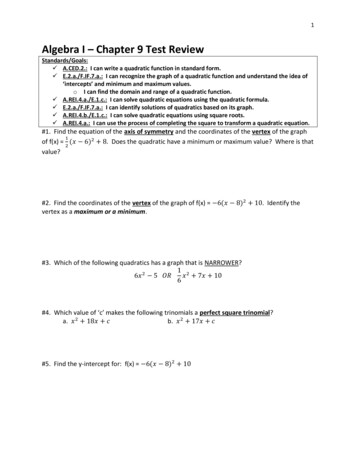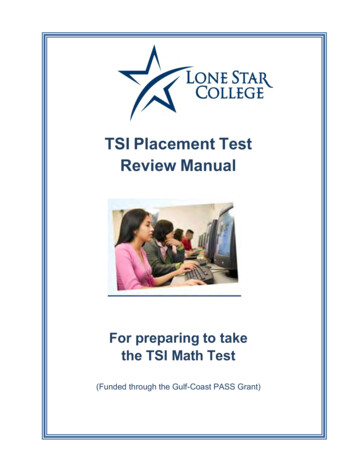
Transcription
1Algebra I – Chapter 9 Test ReviewStandards/Goals: A.CED.2.: I can write a quadratic function in standard form. E.2.a./F.IF.7.a.: I can recognize the graph of a quadratic function and understand the idea of‘intercepts’ and minimum and maximum values.o I can find the domain and range of a quadratic function. A.REI.4.a./E.1.c.: I can solve quadratic equations using the quadratic formula. E.2.a./F.IF.7.a.: I can identify solutions of quadratics based on its graph. A.REI.4.b./E.1.c.: I can solve quadratic equations using square roots. A.REI.4.a.: I can use the process of completing the square to transform a quadratic equation.#1. Find the equation of the axis of symmetry and the coordinates of the vertex of the graph1of f(x) 2 (𝑥 6)2 8. Does the quadratic have a minimum or maximum value? Where is thatvalue?#2. Find the coordinates of the vertex of the graph of f(x) 6(𝑥 8)2 10. Identify thevertex as a maximum or a minimum.#3. Which of the following quadratics has a graph that is NARROWER?1 26𝑥 2 5 𝑂𝑅𝑥 7𝑥 106#4. Which value of ‘c’ makes the following trinomials a perfect square trinomial?a. 𝑥 2 18𝑥 𝑐b. 𝑥 2 17𝑥 𝑐#5. Find the y-intercept for: f(x) 6(𝑥 8)2 10
2#6. Solve 𝑥 2 12𝑥 8 2 by completing the square. Round to the nearest tenth, ifnecessary.#7. Solve 4𝑥 2 11𝑥 3 0 by using the Quadratic Formula. Round to the nearest tenth, ifnecessary.#8. Solve 0 𝑥 2 5.5𝑥 4 by using the Quadratic Formula. Round to the nearest tenth, ifnecessary.#9. You want to enclose a rectangular area with 64 feet of fencing. What is the greatestpossible area that you can enclose with the fence?
3#10. Describe how the graphs of 𝑦 4𝑥 2 5𝑥 𝐴𝑁𝐷 𝑦 4𝑥 2 5𝑥 will differ inappearance?#11. The graph of a quadratic function has x-intercepts at (-7,0) and (15,0). What values for ‘x’would be ‘roots’ of this quadratic function?What is the vertex of each? Additionally, list the transformations for each quadratic.#12. 𝑦 4(𝑥 9)2 10#13. 𝑦 4(𝑥 9)2 10#14. 𝑦 1 4 (𝑥 9)2 10What is a solution for the following equations?#16. 𝑥 2 21 102#17. 𝑥 2 100 0#15. 𝑦 1 4 (𝑥 9)2 10#18. 𝑥 2 100 0#19. What is the side length of a square with an area of 64𝑦 2 ?
4#20. The product of TWO consecutive integers, ‘n’ and ‘n 1’ is 42. What is the positiveinteger that satisfies the situation?#21. MULTIPLE CHOICE QUESTION:
5Quadratics/Discriminant:FIRST: Find the discriminant of each and then state the number and type of roots that eachwill have.SECOND: Solve each using the quadratic formula:#22. 8𝑛2 4𝑛 18#23. 8𝑎2 6𝑎 5#24. Suppose the following was reflected across the x-axis. What would its equation be, afterthis reflection? 𝑦 𝑥 2 9𝑥 17
6#25. The factored form of a quadratic is given by: f(x) (x w)(x 12). If f(x) has a y-interceptat (0,24), the value of ‘w’ must be:#26. What value for ‘w’ would result in 𝑥 8 𝑤 18 having no solution?#27. What value for ‘w’ would result in 𝑤 2𝑥 8 40 in having no solution?#28. What value for ‘w’ would result in 𝑥 2 6𝑥 𝑤 in having NO REAL solutions?#29. What value for ‘w’ would result in 𝑥 2 8𝑥 𝑤 in having ONE real solution?#30. Consider the following: 𝑓(𝑥) 2𝑥 2 16𝑥 8a. What is the vertex of this quadratic?b. What is the axis of symmetry?c. What is the minimum or maximum value?d. What is the domain and range of this function?e. What is the y-intercept?f. What is the discriminant value and how many real solutions will it have?
7Find the discriminant of:#31. 𝑥 2 5𝑥 9 0#32. 3𝑥 2 2𝑥 6What is the vertex of the graphs shown below? Is each vertex a minimum or a maximum? State theaxis of symmetry, y-intercept, domain and range of each.#33.#34.#35.#36. Make a table of values.State the domain and range.XY𝒇(𝒙) 𝟐𝒙𝟐
8#36. Make a table of values.State the domain and range.X𝒇(𝒙) 𝟐𝒙𝟐 𝒙Y#37. MULTIPLE CHOICE QUESTION:
9
10
1 Algebra I - Chapter 9 Test Review Standards/Goals: A.CED.2.: I can write a quadratic function in standard form. E.2.a./F.IF.7.a.: I can recognize the graph of a quadratic function and understand the idea of 'intercepts' and minimum and maximum values. o I can find the domain and range of a quadratic function. A.REI.4.a./E.1.c.: I can .











